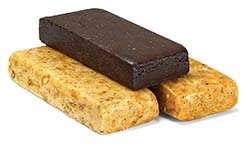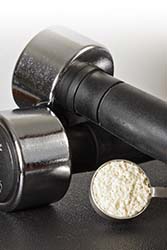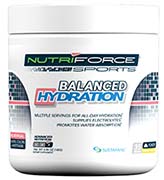Enduring the Road to Recovery
NUTRACEUTICALS
 An article in the April 2014 issue of Food Technology named performance nutrition as one of the top 10 functional food trends. The author, A. Elizabeth Sloan, explained that the sports nutrition category has two distinct performance-driven opportunities: the hardcore athletes/body builders and a less intense, but larger mainstream market of recreational sports participants, casual athletes, and gym exercisers. Although there are differences in the end results and workout routines of the two groups, both the hardcore athlete and casual athlete share similar concerns, including endurance and recovery. Here is a look at some of the ingredients like protein, ribose, L-carnitine, and more that aid in these areas.
An article in the April 2014 issue of Food Technology named performance nutrition as one of the top 10 functional food trends. The author, A. Elizabeth Sloan, explained that the sports nutrition category has two distinct performance-driven opportunities: the hardcore athletes/body builders and a less intense, but larger mainstream market of recreational sports participants, casual athletes, and gym exercisers. Although there are differences in the end results and workout routines of the two groups, both the hardcore athlete and casual athlete share similar concerns, including endurance and recovery. Here is a look at some of the ingredients like protein, ribose, L-carnitine, and more that aid in these areas.
Endurance
When it comes to endurance, caffeine often comes to mind as a compound that provides energy. But concerns with it being an upfront, shorter burst of energy resulting in an energy “crash” have brought about the need for ingredients that can provide endurance throughout a workout or competition.
Bioenergy Ribose® from Bioenergy Life Science Inc., Minneapolis, Minn. (www.bioenergyribose.com), is a 5-carbon carbohydrate that is recognized in the sports nutrition market. Ribose is the structural backbone of critical cellular compounds called purines and pyrimidines, which help form major cellular constituents such as DNA and RNA, cofactors, and certain vitamins. Ribose is also the backbone of adenosine triphosphate (ATP)—the source for all cellular energy. Ribose is the starting point and the rate limiting compound in the synthesis of these fundamental cellular compounds, and it drives the process that replenishes ATP and other energy components in these cells.
Recently, Bioenergy Life Science researchers tested caffeine, ribose, and glucose using a fatigue model to determine the best possible ingredient synergies for formulators (Bioenergy, 2013). The researchers used a standard mice fatigue model. For three days prior to the start of the study, mice swam to the point of exhaustion so that energy reserves were low. A baseline average was taken over the first two days. The mice were fed their normal diet plus one of four treatments on day four. Their endurance was tested again by how long they were able to swim. When given only glucose, the swimming time of the mice returned to about the same as their normal baseline. When given only caffeine, the mice had a swimming time worse than baseline. Swimming time improved by 135% when the mice were given only ribose and improved by 150% when the mice were given a 50/50 ribose and caffeine blend. In the second stage of the study, the researchers determined the optimal combination of the ribose/caffeine concentration. When translated into human equivalents, it was 10 mg/kg of caffeine plus 4 g of ribose. This combination boosted swimming time to 180%.
elevATP™ is a proprietary blend of plant-derived trace minerals with a polyphenol-rich apple extract available exclusively from FutureCeuticals Inc., Momence, Ill. (www.futureceuticals.com). The blend works with the body’s natural energy-producing mechanisms to stimulate production of ATP.
Reyes-Izquierdo et al. (2014) assessed the effect of elevATP in muscle. The researchers gave 20 healthy adult subjects who had fasted and rested an oral placebo on the first day of testing followed by a single, 150 mg dose of elevATP on the second day. Blood was collected immediately prior to treatment, 60 min, and 120 min after ingestion. The ingredient elevATP increased whole blood levels of ATP by 40% after 60 min and by 28% after 120 min. Intramuscular ATP levels from the biopsy of one subject increased significantly at 60 min and 120 min after ingestion, with reported levels substantially higher than even the increases of ATP measured in whole blood. The results indicated that elevATP increased intracellular ATP in blood cells and may increase ATP in muscle tissue.
--- PAGE BREAK ---
ChromaDex, Irvine, Calif. (www.chromadex.com), offers PURENERGY™, a patented co-crystal ingredient comprised of caffeine, and pTeroPure®, a nature-identical form of trans-pterostilbene, which is a potent antioxidant found in blueberries. Research has shown that PURENERGY has the ability to reduce the total amount of caffeine in products by as much as 50% without sacrificing consumers’ expectations (ChromaDex, 2013). The evaluation, which was conducted by scientists from Miami Research Associates, compared the co-crystallized caffeine in PURENERGY with ordinary caffeine. The findings showed that PURENERGY delivered almost 30% more caffeine into the blood than ordinary caffeine, and the rate of caffeine absorption was significantly slower compared to ordinary caffeine. The test subjects taking PURENERGY showed significantly less fatigue and greater concentration compared to baseline. At 6 hours, the subjects also showed improved energy, alertness, and focus compared to baseline.
Slowly digestible carbohydrates such as sucromalt and isomaltulose can be used to provide prolonged energy. Xtend® Sucromalt from Cargill, Minneapolis, Minn. (www.cargillfoods.com), is a full-calorie, low-glycemic sweetener that is 70% as sweet as sugar. A preliminary study conducted in 2012 showed that sucromalt may help maintain mental and physical energy better than glucose (Cargill, 2012). The study found that subjects who drank a beverage containing sucromalt better maintained feelings of mental and physical energy over time compared to when they consumed a beverage made with glucose. The results showed that subjects reported significantly greater mental and physical energy, delayed physical fatigue, and a trend toward less mental fatigue when they consumed sucromalt compared to glucose, particularly four to five hours after consumption.
Palatinose™ (isomaltulose) from BENEO Inc., Morris Plains, N.J. (www.beneo.com), is ideal for sports nutrition thanks to its sustained energy supply and increased fat oxidation properties. Hydrolysis and absorption in the body is complete but much slower compared to sucrose and other sugars. Palatinose provides a constant and extended stream of energy from its caloric value of 4 kcal/g for muscles and the brain. This source of energy lasts over a longer period of time compared to quickly absorbed carbohydrates.
L-carnitine is essential for transporting long-chain fatty acids across the mitochondrial membrane for subsequent fat breakdown and energy generation. Studies show that Carnipure™ tartrate supplementation from Lonza Inc., Allendale, N.J. (www.lonza.com), can support recovery after exercise. The researchers observed a decrease in the production of free radicals, less tissue damage, and reduced muscle soreness after exercise in recreationally trained athletes following three weeks of Carnipure supplementation. These effects were found to be dose-dependent, present both in young and old, male and female subjects. Supplementation with Carnipure tartrate was found to induce an increase in muscle oxygen consumption, providing a potential mechanism for reduced hypoxic stress following resistance exercise.
 Peptides are short chains of two or more amino acids and are used in sports nutrition products. “Glanbia Nutritionals’ research into sports nutrition peptides resulted in an optimized product technology, PepForm® Peptides,” says Shanna Smidt, Business Development Manager—Sports Nutrition, Glanbia Nutritionals, Fitchburg, Wis. (www.glanbianutritionals.com). The ingredient platform contains high levels of amino acid-rich peptides. Some of the peptides in this line include citrulline, arginine, and glutamine. PepForm Citrulline helps increase exercise capacity and is a key in the nitric oxide cycle. PepForm Arginine is converted to nitric oxide in the body where it helps to support healthy blood flow and nutrient delivery. PepForm Glutamine peptides support exercise recovery and cellular energy.
Peptides are short chains of two or more amino acids and are used in sports nutrition products. “Glanbia Nutritionals’ research into sports nutrition peptides resulted in an optimized product technology, PepForm® Peptides,” says Shanna Smidt, Business Development Manager—Sports Nutrition, Glanbia Nutritionals, Fitchburg, Wis. (www.glanbianutritionals.com). The ingredient platform contains high levels of amino acid-rich peptides. Some of the peptides in this line include citrulline, arginine, and glutamine. PepForm Citrulline helps increase exercise capacity and is a key in the nitric oxide cycle. PepForm Arginine is converted to nitric oxide in the body where it helps to support healthy blood flow and nutrient delivery. PepForm Glutamine peptides support exercise recovery and cellular energy.
Recovery
When it comes to exercise or workout recovery, there are several concerns that athletes have. Fluids and electrolytes need to be replenished, they experience soreness, and proteins need to be consumed to aid in the repair of broken-down or damaged muscle. The area of sports recovery has opened the door to some novel ingredients and research for optimum recovery.
Proteins and peptides are essential for recovery because of their role in muscle synthesis. “We continue to see a growing interest in sports nutrition products and higher-quality proteins,” observes Jessica Henry, Marketing Manager, Idaho Milk Products, Jerome, Idaho (www.idahomilkproducts.com). “Much of this growth is coming from new customers: women who recognize that sports nutrition products can help them achieve their fitness goals, Baby Boomers who want to age well, and recreational sports participants and healthy lifestyle consumers who find new products that are geared to their needs, rather than just those of hardcore athletes and body builders.”
--- PAGE BREAK ---
 IdaPro® Milk Proteins contain undamaged, lowheat-processed, native structure milk proteins. They are manufactured through the filtration of skim milk and contain all of the proteins naturally found in milk, including micellar casein and native whey proteins in their pure state. “IdaPro Milk Proteins are an excellent source of bioactive fastdigesting (whey) and slow-digesting (micellar casein) dietary proteins,” says Henry. “An obvious benefit of milk protein is the high, concentrated protein content with an outstanding amino acid profile that is better than casein and/or caseinates and almost equal to whey proteins.” IdaPro Milk Proteins contain both micellar casein and whey proteins, thereby providing optimal metabolic benefits in one key ingredient.
IdaPro® Milk Proteins contain undamaged, lowheat-processed, native structure milk proteins. They are manufactured through the filtration of skim milk and contain all of the proteins naturally found in milk, including micellar casein and native whey proteins in their pure state. “IdaPro Milk Proteins are an excellent source of bioactive fastdigesting (whey) and slow-digesting (micellar casein) dietary proteins,” says Henry. “An obvious benefit of milk protein is the high, concentrated protein content with an outstanding amino acid profile that is better than casein and/or caseinates and almost equal to whey proteins.” IdaPro Milk Proteins contain both micellar casein and whey proteins, thereby providing optimal metabolic benefits in one key ingredient.
Glanbia Nutritionals offers Hydrovon™ 195, a partially hydrolyzed whey protein isolate designed for rapid absorption by the body. It helps to speed up post-athletic recovery while eliminating the bitter taste common to this type of whey protein. Hydrovon 195 is rich in branched-chain amino acids (BCAAs) that help with maintaining post-workout lean muscle and accelerating muscle recovery and repair.
The BCAAs leucine, isoleucine, and valine constitute about a third of the protein in skeletal muscle. Leucine in particular has an important role in supporting muscle growth and development, explains Smidt. “Consuming protein before training increases the amount of amino acids available to muscles during exercise. To promote muscle maintenance and strength, athletes should select sources of fast-absorbing branched-chain amino acids.”
The amino acids contained in Glanbia’s PepForm peptides trigger muscle synthesis, making them ideal for pre- and post-workout consumption. PepForm BCAA peptides include leucine, isoleucine, and valine in a 2:1:1 ratio along with whey peptides, which can help the utilization of beneficial amino acids and provide a convenient form of BCAAs. PepForm Leucine is a patent-pending high-leucine (>40%) peptide ingredient that uses a whey protein peptide backbone to bind L-leucine, a key amino acid that triggers muscle protein synthesis through the mTOR pathway.
Arla Foods Ingredients, Basking Ridge, N.J. (www.arlafoodsingredients.com), offers advanced whey protein ingredients for sports nutrition manufacturers. Easily digested and rapidly absorbed, HYDRO.365 has the potential to reduce recovery time from days to hours when consumed within two hours of training. HYDRO.365 is an advanced whey protein hydrolysate that is digested and absorbed much faster than standard whey protein. It is pre-digested, meaning that the protein units have been pre-digested into smaller units called peptides. This gives them faster access to the bloodstream. Another ingredient from the company, Lacprodan® DI-7017, is an advanced whey protein that supports the increasing numbers of “ordinary” health-conscious consumers who are demanding food and beverage products that help them stay fit, toned, and looking and feeling good. Lacprodan DI-7017 is high in BCAAs and offers a quicker digestion time.
--- PAGE BREAK ---
 Sustamine® L-Alanyl-L-Glutamine from Kyowa Hakko USA, New York, N.Y. (www.kyowa-usa.com, www.sustamine.com), is a stable dipeptide of L-alanine and L-glutamine. Sustamine is more easily absorbed by the body than complex protein molecules, making it a highly effective ingredient for hydration, endurance, and recovery. It enhances performance and recovery in three primary ways: replacing lost electrolytes and fluids, repairing damaged muscle proteins, and refilling the body’s energy stores. Sustamine is featured in a new product from NutriForce Sports called Balanced Hydration. Introduced in 2014, Balanced Hydration contains Sustamine and bioavailable forms of electrolytes necessary for hydration to meet the needs of weekend warriors, recreational lifters, and elite-level athletes.
Sustamine® L-Alanyl-L-Glutamine from Kyowa Hakko USA, New York, N.Y. (www.kyowa-usa.com, www.sustamine.com), is a stable dipeptide of L-alanine and L-glutamine. Sustamine is more easily absorbed by the body than complex protein molecules, making it a highly effective ingredient for hydration, endurance, and recovery. It enhances performance and recovery in three primary ways: replacing lost electrolytes and fluids, repairing damaged muscle proteins, and refilling the body’s energy stores. Sustamine is featured in a new product from NutriForce Sports called Balanced Hydration. Introduced in 2014, Balanced Hydration contains Sustamine and bioavailable forms of electrolytes necessary for hydration to meet the needs of weekend warriors, recreational lifters, and elite-level athletes.
A recent study showed that a soy-dairy protein blend consumed post-workout prolonged the delivery of select amino acids to the muscle for an hour longer than using whey alone (DuPont Nutrition & Health, 2014). It also showed a prolonged increase in amino acid net balance across the leg muscle during early post-exercise recovery, suggesting prolonged muscle building. The double-blind, randomized clinical trial included 16 healthy subjects, ages 19–30 and assessed if consumption of a blend of proteins with different digestion rates would prolong amino acid availability and lead to increases in muscle protein synthesis after exercise. The protein beverages consisted of a soy-dairy blend (25% isolated DuPont™ Danisco® SUPRO® soy protein from DuPont Nutrition & Health, St. Louis, Mo., www.food.dupont.com, 50% caseinate, 25% whey protein isolate) or a single protein source (whey protein isolate). Muscle biopsies were taken at baseline and up to 5 hours after resistance exercise. The protein beverages were ingested 1 hour after exercise. The results showed that the soy-dairy blend yielded an increase in select amino acid delivery for about an hour longer than the whey protein. The blend also sustained a greater positive net amino acid balance than whey, suggesting there is less muscle protein breakdown during the time period shortly after consumption of a blended protein product.
Methylsulfonylmethane (MSM) is associated with joint health due to its anti-inflammatory and antioxidant effects. It is becoming increasingly popular in the sports nutrition market for its potential role aiding recovery. Giant Sports Products in 2013 added OptiMSM® from Bergstrom Nutrition, Vancouver, Wash. (www.bergstromnutrition.com), to its pre-workout formula, Metabolic Bioshock®. Resistance exercise is known to induce both inflammation and oxidative stress, resulting in muscular discomfort and pain. Kalman et al. (2013) showed that consuming 3 g of OptiMSM/day for 14 days resulted in significantly lower pain and discomfort two hours following the performance of a leg extension exercise done until muscle failure when compared to placebo. The researchers concluded that MSM may help alleviate the pain and discomfort that can follow a stressful exercise session.
Tart cherries are promoted for their anti-inflammatory benefits among those who suffer from arthritis and gout. More research is being conducted on the potential benefits of using tart cherry juice for easing muscle soreness after exercise. Tart cherries seem to help due to their concentrated amounts of anthocyanins. Bell et al. (2014) demonstrated the effects that Montmorency tart cherries had on inflammation and oxidative stress after high-intensity cycling. The subjects were 16 well-trained, male cyclists who drank about 1 oz (30 ml) of Montmorency tart cherry juice concentrate mixed with water (equivalent to 90 whole Montmorency tart cherries/serving), or a calorie-matched placebo, twice a day for seven days. The subjects who drank Montmorency tart cherry juice concentrate before a three-day simulated race experienced less inflammation and oxidative stress compared to those who drank another beverage.
Horphag Research, Geneva, Switzerland (www.pycnogenol.com), produces Pycnogenol®, an antioxidant from French maritime pine tree bark. Vinciguerra et al. (2013) showed that the ingredient was effective in improving performance and endurance and reducing muscle cramping and soreness by controlling oxidative stress in both recreational athletes and triathletes. The subjects consumed 100–150 mg of Pycnogenol daily over the course of the study.
 Linda Milo Ohr,
Linda Milo Ohr,
Contributing Editor,
Denver, Colo.
[email protected]
References
Bell, P.G., Walshe, I.H., Davison, G.W., Stevenson, E., and Howatson, G. 2014. Montmorency cherries reduce the oxidative stress and inflammatory responses to repeated days high-intensity stochastic cycling. Nutrients 6: 829-843.
Bioenergy. 2013. New study indicates a combination of ribose and caffeine may be superior at fighting fatigue. Press release, Dec. 17.
Cargill. 2012. Preliminary study published in Nutritional Neuroscience finds sucromalt may help to maintain mental and physical energy better than glucose. Press release, Dec. 3.
ChromaDex. 2013. Clinical study demonstrates ChromaDex’s caffeine alternative, PURENERGY™, delivers 30% more caffeine, stays in the bloodstream longer and is absorbed more slowly than ordinary caffeine. Press release, Sept. 25.
DuPont Nutrition & Health. 2014. DuPont, University of Texas Medical Branch study reaffirms soy-dairy protein blend extends duration of amino acid delivery to muscle. Press release, April 24.
FutureCeuticals Inc. 2014. FutureCeuticals Inc. announces second successful study on ability of elevATP™ to increase intracellular and intramuscular ATP levels. Press release, March 19.
Kalman, D.S., Feldman S., Samson, A., and Krieger, D.R. 2013. A randomized double blind placebo controlled evaluation of MSM for exercise induced discomfort/pain. FASEB J. 27: 1076-1077.
Reyes-Izquierdo, T., Shu, C., Argumedo, R., Nemzer, B., and Pietrzkowski, Z. 2014. The effect of elevATP™ on whole blood ATP levels: a single dose, crossover clinical study. J. Aging Res. Clin. Practice 3(1): 56-60.
Vinciguerra, G., Belcaro, G., Bonanni, E., Cesarone, M.R., Rotondi, V., Ledda, A., Hosoi, M., Dugall, M., Cacchio, M., and Cornelli, U. 2013. Evaluation of the effects of supplementation with Pycnogenol® on fitness in normal subjects with the Army Physical Fitness Test and in performances of athletes in the 100-minute triathlon. J. Sports Med. Phys. Fitness 53(6): 644-654.


